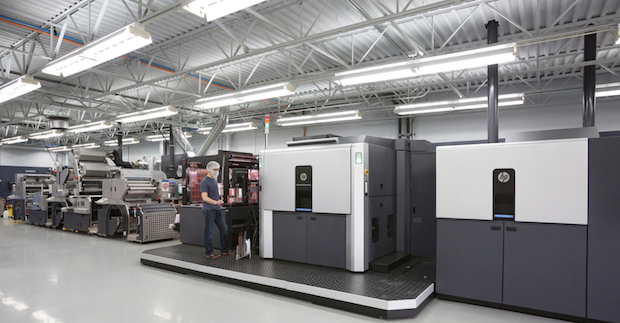For anyone who needs reminding, the HP Indigo 20000 is a rare bird. First sighted at HP Indigo’s drupa 2012 booth, it’s a 30" electrophotographic web press costing well over $1 million. It is also the only color digital press specifically designed for flexible packaging; without HP Indigo, that application would still be nearly all printed in analog.
We recently had the chance to interview Innovative Labeling Solutions (ILS), a development partner to HP Indigo and likely the most experienced user of the HP Indigo 20000. How does ILS use the HP Indigo 20000 now? What effect has the printer had on the company’s business? What’s the outlook for this type of digital printing at ILS and elsewhere? We put these and other questions to ILS CEO Jay Dollries.

The HP Indigo 20000 at Innovative Labeling Solutions
ILS installed HP the Indigo 20000 at its Hamilton, OH, facility in March 2014. The press has been running two and even three shifts five days per week since that time, and the company installed a second 20000 in late January 2016.
“We’re happy with the 20000. In fact, the heavy use of the original unit is what spurred us to invest in a second one,” Dollries said. “The 20000 has been profitable for us, and not just for flexible packaging.” He explained that flexible packaging such as stand-up pouches and pillow-type bags represent about 50% of the printing that ILS does on the HP Indigo 20000, and the remainder is split about evenly between shrink sleeves and pressure-sensitive labels.

Jay Dollries with the Digicon 3000 Finisher by AB Graphics International
The HP Indigo 20000 application split reminded us of the history of ILS, which was founded in 1996 as a flexo label converter. For the next nine years, presses at ILS were just narrow flexo webs, but in 2005 ILS bought its first color digital label press, the narrow web (13") HP Indigo WS4000, to print the short label runs that can be a problem for flexo. In 2008, ILS became a beta site for HP Indigo WS6000, also a 13" web. Although that printer is also a narrow web, ILS began printing flexible packaging on it as an extra application.
2009 was the year InfoTrends first visited ILS at its Ohio site, and we saw the company’s then new “digital room” housing the WS4000, a WS6000, a first ABG Digicon, and even a first Karlville unit for sealing those first runs of flexible packaging. Today, that same room is packed with color digital equipment.
As noted earlier, flexible packaging is an important application for the company. Besides the two HP Indigo 20000s, the digital room holds four HP Indigo WS6000 Series presses, 3 ABG Digicon finishing lines (near line, two with the WS6000s, plus Digicon 3000 near line for the 20000), and a Delta Modtech Spectrum finishing line, in-line with one of the WS6600s.

The digital room at Innovative Labeling Solutions
“Yes, we’re still a flexo label converter, because that’s still the best option for any long run of a single SKU or maybe a few SKUs,” Dollries said. “But, digital printing is just very well suited to the short runs and the bigger, multi-SKU jobs that brands increasingly want to do, so today digital is most of our business. We’re still mainly a label converter, but HP Indigo has helped us branch into flexible packaging, first with the WS6000, and now with the 20000.” Color digital printing has grown steadily at ILS, Dollries added, accounting for 78% of revenues in 2015.
Dollries made other points about the 20000 and color digital printing at his company. The press’s 30" web has enabled ILS to print much larger flexible packaging structures than it can print with its narrow-web HP label presses, with “bag in a box” wine packages and fertilizer bags as examples. Additionally, most flexible packaging on the 20000 is reverse printed and then laminated, thus encasing print between barrier layers, a common requirement for food packaging.
What about variable data printing? “As a share of jobs, VDP is tiny,” Dollries said. “But those jobs also net a higher margin, such as to print serialized codes, or to vary the design so that each package is unique.” He added that of the 95% of jobs on the 20000 that are fixed images, many of them gang a high number of SKUs, as many as 150 in one run. “For jobs like that, flexo is not really an option,” Dollries noted. “Instead, you need the flexibility of a digital system.”
On reflection, in the time that we’ve known about ILS, the company has been an incubator for color digital presses for packaging, first with the HP Indigo WS6000 and now with the 20000. What will the future hold? Dollries believes that brands will always want to separate themselves from others, and that digital presses will help, quite possibly with methods and techniques that are unknown to us now.
“In the future, the focus won’t be on crossover points for flexo and digital. It will be on retail shelf experience. Brands will always want to do new things in retail, to engage with small groups and even individuals,” Dollries said. “Short runs will meet more and more of that need, and so will VDP, with digital printing as the enabler. Digital has become a vital part of label converting. Soon it will have the same role in flexible packaging.”














